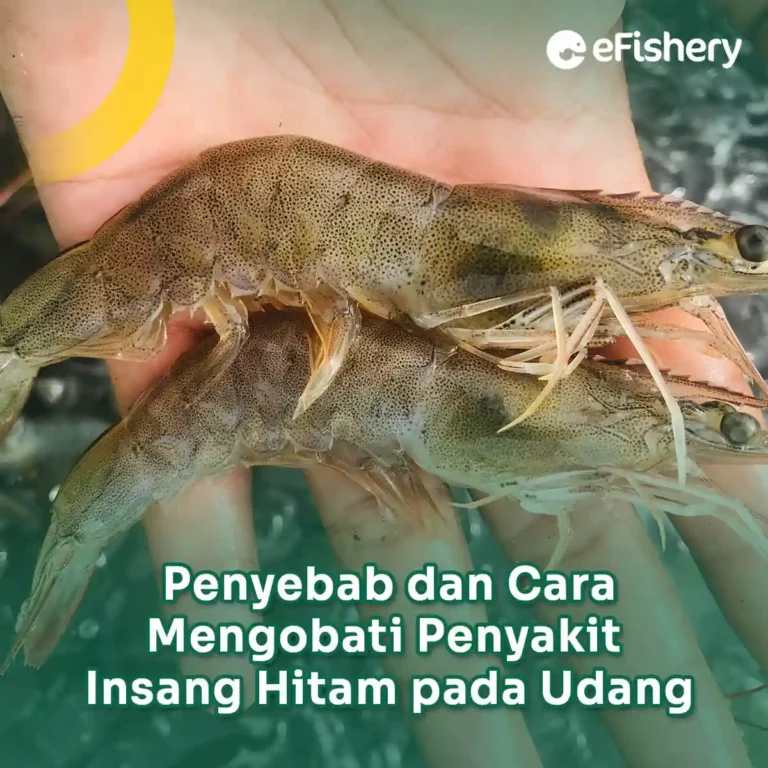Artikel Ini Telah Direview Oleh:

Anggie Nur
Magister Bioteknologi
Shrimp disease is caused by biotic and abiotic factors. These factors can become a problem when the shrimp are in a weak condition and the environment is not good. One of the diseases that can attack shrimp is black shrimp gill disease.
Black gill disease in shrimp caused by a fungus Fusarium sp. which arise due to poor environmental conditions, leading to the occurrence of certain bacterial and fungal attacks on the gills of shrimp. Black gill disease can cause slow growth and decreased shrimp survival. This disease causes the gills of the shrimp to swell so that the gill covers open, causing the death of the shrimp.
The following is complete information regarding black gill disease in shrimp that must be considered!
Symptoms and Characteristics of Black Gill Disease
Black Gill Disease or black gill disease is a disease in shrimp that live in water environments with NH levels3 and NO2 tall one. Shrimp that have this disease often experience discoloration of the gills from ivory white to brown or black with lesions on the gills. Other clinical signs that can be seen in shrimp with black gill disease are difficulty breathing, floating, eating less, and finally dying.
Black gill disease is caused by Fusarium sp. on shrimp. Fusarium sp. can infect dead tissue, causing movement difficulties due to mycelium growth and causing high mortality in shrimp culture populations. This problem can be solved by providing shrimp nutrition and maintaining water quality in shrimp ponds. Apart from being caused by fungi, chemical contaminants such as oil, cadmium, copper, zinc, potassium permanganate, ozone, as well as the presence of high organic matter due to leftover feed and dirt on the pond bottom are also responsible for the appearance of black gill disease in ponds.
How to Treat Black Gill Disease in Shrimp
Here's how to treat black gills on shrimp:
- Perform 10-30% water changes for 3 consecutive days. This water exchange is carried out gradually and adjusts to the availability of water
- Lime spread (CaOH)2 at night as much as 5-10 ppm
- Give fermented bran and molasses/molasses with a ratio of 1:2 per 2 ppm. Do it for 3 days in a row until the color of the pond water changes
- Give supporting bacteria such as Rhodococcus and Rhodobacter in the afternoon as much as 0.5-1 ppm
Treatment of black gills must be carried out successively. This is to maximize the healing of shrimp affected by black gills and prevent death. You also have to take precautions starting from preparing the pond until the cultivation process takes place to anticipate black gill attack on the shrimp.
How to Prevent Black Gill Disease in Shrimp
The best way to prevent black gill disease in shrimp is to keep the shrimp healthy. The three most important parts of shrimp pond management to keep shrimp healthy and free from black gill disease are:
1. Pool Preparation
Ponds should be prepared for stocking by cleaning, drying and filling with filtered and disinfected water. The soil or pond bottom used for cultivation that has not been cleaned will turn black like mud and may become rotten with a pungent odor. This black mud contains hydrogen sulfide which is toxic to shrimp.
All black mud at the bottom of the pond must be removed by cleaning and brushing (for ponds using HDPE tarpaulin) or by plowing (for earthen ponds). Then, the bottom of the pond must be dried in the sun for at least two weeks.
This will allow any remaining disease-causing organisms, such as fungi, protozoa, bacteria, and viruses, to be killed. At the same time, the organic matter remaining in the pond will oxidize and become non-toxic.
After that, the pool must be filled with water that has been disinfected and filtered through a 1 millimeter sieve. Before the fry are spread, the pond water must be left for three to four days.
2. Feeding
In order to meet the rapid growth and good health of the shrimp, the shrimp feed should have the following criteria:
- High quality
- Has a protein content of at least 40%
- Feed must be in good condition
- Stored in a clean, dry place away from rats or other pests
- Feed should not be older than 6 months.
Feed should be given four times a day according to the amount determined by checking how long the feed is left in the anco. If the feed runs out in one and a half hours, then the feed must be added. If the feed is still in the anco after two hours, then the amount of feed must be reduced. Shrimp must receive adequate feed if they are to grow quickly and stay healthy.
Overfeeding shrimp will pollute ponds and lead to increased growth of organic matter on the pond bottom, thereby encouraging the growth of harmful bacteria and other disease-causing organisms. Therefore, the amount of feed that is spread must always be adjusted to the appetite and growth needs of the shrimp.
3. Management of Water Quality and Sludge Disposal
Regular water changes are necessary to keep the pond bottom clean. The water exchange rate should be around 5% per day for the first two months of rearing, 10% per day during the third month of rearing, and thereafter should be increased to 20% per day until the shrimp are harvested.
Use aerators with sufficient quantities to support dissolved oxygen needs and maintain DO at > 5 ppm. Siphon regularly to reduce the accumulation of organic matter in the pond bottom. In addition, periodically check the water quality during cultivation and ensure that the water quality parameters are in the optimum range.
Cegah Penyakit Insang Hitam di Konsultasi Budidaya eFarm!
Need Help Regarding Shrimp Cultivation Business?
Fill in your personal data in the following form. Our team will immediately contact you via the number cellphone attached. Make sure the data entered is correct.
Black gill disease shrimp show typical signs of black gill disease and death about a month before harvest. By managing good water quality and measuring feed, you can avoid the causes of black disease in shrimp and consult the problem through the features Cultivation Consultation in eFarm.
eFarm is an application that aims to help overcome problems around shrimp farming. This application provides several features that you can access for free, one of which is a feature Cultivation Consultation. This feature will help you who want to find solutions to problems that occur in ponds.
So what are you waiting for? consult your problem now!

Anggie Nur - Magister Bioteknologi
Anggie merupakan lulusan sarjana dan magister bioteknologi serta memiliki pengalaman riset di dunia perikanan khususnya udang
Questions Regarding the Causes and How to Treat Black Gill Disease in Shrimp
Disease Black Gill Disease is black gill disease in shrimp caused by Fusarium sp. This disease occurs due to bad environmental conditions so that certain bacteria and fungi attack the shrimp gills.
Shrimp that have this disease often experience discoloration of the gills from ivory white to brown or black with lesions on the gills. Other clinical signs that can be seen in shrimp with black gill disease are difficulty breathing, floating, eating less, and eventually dying.
- Dewangan NK and Gopalakrishnan A. 2015. Black gill disease of Pacific white leg shrimp (Litopenaeus vannamei) by Aspergillus flavus. Journal of Coastal Life Medicine. Vol.3(10):761-765.
- Reza SL, Mohammad T, Mohsen F, Afshin Z, Sahar M, Ehsan K, Mohammad F. 2015. Histological Gills Changes of Marine Shrimp in Black Gill Disease in the Bushehr Seacoast. Biomedical & Pharmacology Journal. Vol. 8(1): 255-260.
- https://infoduniaperikanan.wordpress.com/2018/11/24/hati-hati-insang-hitam-pada-udang-vannamei/
